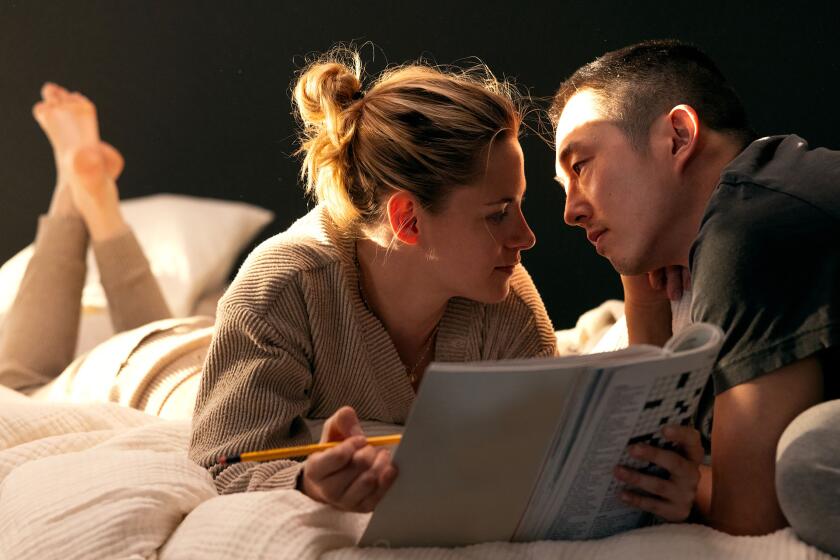Early Music Gets Short Shrift in ‘Elizabeth’
- Share via
How much longer do we have to put up with filmmakers spending zillions of dollars on costume dramas but making a mess of the music?
The latest in a long line of offending films is “Elizabeth,” a sympathetic portrayal of the 16th century English monarch as she struggles to fill the shoes of her father, Henry VIII, and unite a fractious nation divided by religion. Cate Blanchett is captivating as Elizabeth, and she’s supported by fine performances from several others. Acting is not the problem.
Like Kenneth Branagh’s productions of Shakespeare, this film convincingly evokes a past world-- except when it comes to the music.
Classic is the scene in “Henry V” in which, as Henry, Branagh leaves the field of battle at Agincourt after annihilating a superior French force. He walks wearily through the realistic squalor and desolation of a 15th century battlefield and begins singing (on screen) a late 18th century-style, very Mozartean “Non nobis, Domine.” This is about as egregious as having the Pilgrim Fathers arrive on the Mayflower in a movie and sing something by Steve Reich--the years between the event and the music are about the same.
If Branagh has so much respect for the 15th century, researching so many details of costumes, manners and artifacts, why doesn’t he use music that springs from the same aesthetic as those other expressions of period culture?
What could he have used instead? One of the most striking English pieces of the early 15th century is known today as the “Agincourt Carol,” a stirring song for soloist and ensemble singers about Henry’s victory at Agincourt. It would have made a stunning, memorable and moving musical event at that point in the film. This was a missed opportunity, never to be recovered, perhaps, until the next “Henry V” remake in 50 years.
Films depend a great deal on the effect of the music: the huge swells to fortissimo at dynamic points, the liveliness of happy scenes, the spookiness that augurs something bad, the sentimentalism of romance. Take away the music track and a lot of movies today might seem very naked and a whole lot less--well--moving. But in these grand historical films whose success depends on the evocation of the age, not to use historically appropriate music is an underestimation of what it can do to enhance the product.
In “Elizabeth,” we find an odd mixture of things. There is some glorious choral music by Thomas Tallis that is just right for the coronation scene. Later, when the Duke of Anjou arrives to court Elizabeth, there is some charming mid-16th century dance music by Susato, although it’s performed as a foppish joke, the implication being that English people wouldn’t stoop to such trivialities.
*
Then there’s the dancing. Yes, in the 16th century there really was a risque dance called LaVolta, and Elizabeth reportedly loved to dance it regularly as a kind of “Jazzercise” routine. But no, it really didn’t look anything like the tango, as it does in “Elizabeth.” Renaissance dance specialists across America--from Boston to New York to San Francisco--are probably spinning in their graves. Actually, the ones I know weren’t dead last time I checked, but I figure the dancing in “Elizabeth” probably killed them. Oh, if only they’d been asked to help!
Where “Elizabeth” really loses faith in period music, however, is toward the end. A sentimental scene is suffused with Edward Elgar’s “Enigma Variations” (composed about 1899), a beautiful and moving work that swells the hearts of Anglophiles everywhere but has very little to do with the Renaissance.
The real stunner, however, comes in the final scene in which Mozart’s Requiem accompanies Elizabeth’s self-induced transformation into the “Virgin Queen.” In the most glorious age of English music, if director Shekhar Kapur and his designers were not able to find something suitable and more effective as a musical background to the climax of this drama, they were either badly informed or they didn’t look very hard.
Just imagine if they had used the Tallis motet “Spem in alium,” composed in honor of Elizabeth, probably within a year of the final scene of the movie. Think of ethereal soprano lines, the splendor of 40--count ‘em, 40--separate voice parts (eight five-voice choirs singing simultaneously), the mystery of interweaving voices united in majestic harmony. The music would have lifted people out of their seats, just as the “Agincourt Carol” would have lifted people out of their seats in Henry V.
I don’t say this because period music is “historically correct.” I say it because I believe in the beauty and power of this music more than filmmakers do. This isn’t pedantry. It’s production values. It’s moving people’s hearts. If audiences are moved by characters and stories from the past, then I think they’d be moved even more by hearing period music that really fits. I hope, one day, they’ll be given a chance to find out.
Ross W. Duffin is a professor and chair of the music department at Case Western Reserve University in Cleveland.
More to Read
Only good movies
Get the Indie Focus newsletter, Mark Olsen's weekly guide to the world of cinema.
You may occasionally receive promotional content from the Los Angeles Times.










